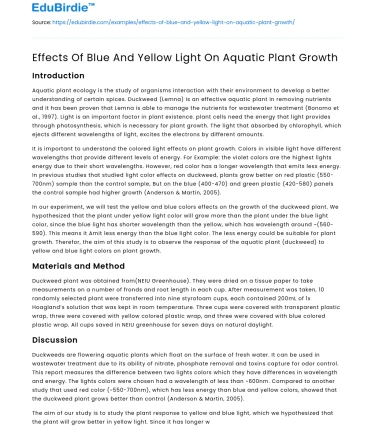Introduction
Aquatic plant ecology is the study of organisms interaction with their environment to develop a better understanding of certain spices. Duckweed (Lemna) is an effective aquatic plant in removing nutrients and it has been proven that Lemna is able to manage the nutrients for wastewater treatment (Bonomo et al., 1997). Light is an important factor in plant existence. plant cells need the energy that light provides through photosynthesis, which is necessary for plant growth. The light that absorbed by chlorophyll, which ejects different wavelengths of light, excites the electrons by different amounts.
It is important to understand the colored light effects on plant growth. Colors in visible light have different wavelengths that provide different levels of energy. For Example: the violet colors are the highest lights energy due to their short wavelengths. However, red color has a longer wavelength that emits less energy. In previous studies that studied light color effects on duckweed, plants grow better on red plastic (550-700nm) sample than the control sample, But on the blue (400-470) and green plastic (420-580) panels the control sample had higher growth (Anderson & Martin, 2005).
Save your time!
We can take care of your essay
- Proper editing and formatting
- Free revision, title page, and bibliography
- Flexible prices and money-back guarantee
In our experiment, we will test the yellow and blue colors effects on the growth of the duckweed plant. We hypothesized that the plant under yellow light color will grow more than the plant under the blue light color, since the blue light has shorter wavelength than the yellow, which has wavelength around ~(560-590). This means it Amit less energy than the blue light color. The less energy could be suitable for plant growth. Therefor, the aim of this study is to observe the response of the aquatic plant (duckweed) to yellow and blue light colors on plant growth.
Materials and Method
Duckweed plant was obtained from(NEIU Greenhouse). They were dried on a tissue paper to take measurements on a number of fronds and root length in each cup. After measurement was taken, 10 randomly selected plant were transferred into nine styrofoam cups, each contained 200mL of 1x Hoagland’s solution that was kept in room temperature. Three cups were covered with transparent plastic wrap, three were covered with yellow colored plastic wrap, and three were covered with blue colored plastic wrap. All cups saved in NEIU greenhouse for seven days on natural daylight.
Discussion
Duckweeds are flowering aquatic plants which float on the surface of fresh water. It can be used in wastewater treatment due to its ability of nitrate, phosphate removal and toxins capture for odor control. This report measures the difference between two lights colors which they have differences in wavelength and energy. The lights colors were chosen had a wavelength of less than ~600nm. Compared to another study that used red color (~550-700nm), which has less energy than blue and yellow colors, showed that the duckweed plant grows better than control (Anderson & Martin, 2005).
The aim of our study is to study the plant response to yellow and blue light, which we hypothesized that the plant will grow better in yellow light. Since it has longer wavelength and less energy emitted to plant, that can be suitable for the plant to growth more than blue light color. The results from our group data showed that there are no significant differences between the blue, yellow, and control in neither root length nor number of leaves. However, the root length from the class data showed slightly higher growth in the duckweed under yellow light, but the blue and control showed no difference, which still not a significant difference (Fig3). Most of the plant were dead in all cups even the control ones. This might happened due to the fact that the cups were stored under natural light in cloudy weather, which could be less than the plants needs of light source. Also, the drying time on the tissue paper could effected the plant growth in this experiment. In future studies, we want to test other light colors with longer wavelengths and less energy that would be more effective on plant growth.
References
- Konica Minolta. (n.d.). Can Colored Lights Affect How Plants Grow? Retrieved February 11, 2019, from https://sensing.konicaminolta.us/blog/can-colored-lights-affect-how-plants-grow/
- Understanding Photosynthesis: How Does Chlorophyll Absorb Light Energy? (n.d.). Retrieved February 11, 2019, from http://www.saps.org.uk/secondary/teaching-resources/283-photosynthesis-how-does-chlorophyll-absorb-light-energy
- Bonomo, L., Pastorelli, G., & Zambon, N. (1997). Advantages and limitations of duckweed-based wastewater treatment systems. Water Science and technology, 35(5), 239-246.
- Anderson, L., & Martin, D. F. (2005). Effect of Light Quality on the Growth of Duckweed, Lemna minor L. Florida Scientist, 20-24.






 Stuck on your essay?
Stuck on your essay?

